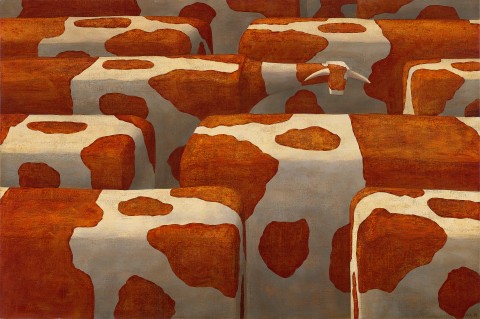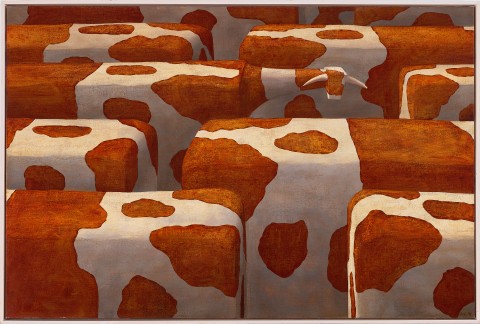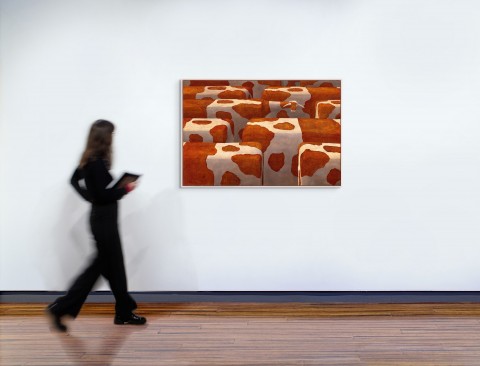PAINTED LABYRINTH, 1996
JOHN KELLY
oil on linen
91.5 x 137.0 cm
signed and dated lower right: Klly [sic] 96
dated and inscribed with title verso: PAINTED LABYRINTH / 1996
Niagara Galleries, Melbourne (label attached verso)
Private collection, Melbourne, acquired from the above
Standing out in the centre of this tightly packed array of cow’s hinds, arranged in a continuous running bond pattern like bricks, is a lone bull – his small head turned towards the viewer as if animated with conscious and independent thought. Australian painter John Kelly created Painted Labyrinth, 1996 during a prolific period while studying at the Slade School of Art in London after winning the Anne & Gordon Samstag International Visual Arts Scholarship in 1995. Kelly has been internationally acclaimed for these works featuring his obsessive bovine theme, which beyond cartoonish humour is anchored in surreal historical fact and images from modern Australian art history. While Russell Drysdale’s paintings and Sidney Nolan’s photographs of emaciated, drought-stricken livestock certainly informed the cultural and geographic relevance of Kelly’s chosen avatars, it is the often-related story of William Dobell’s wartime papier-mâché decoys that truly provided the impetus and the stranger-than-fiction scenes that have appeared in a large majority of Kelly’s works.
Australian painter William Dobell during World War Two served as a camouflage labourer. Almost inconceivably bizarre was his task of making papier-mâché cows, intended to be dotted around airfields and other military targets to lead enemy pilots into thinking the land was merely pastoral. By 1996, Kelly had been steadily painting imagined scenes of Dobell’s decoy cows for several years. While in some scenes the boxy figures of the cows are clearly static sculptures (unfinished, unpainted and upended on trestle tables, for example), other paintings by Kelly present them in tightly cropped vignettes that give little indication of the broader context. Here, the painted rectangular bodies are arranged neatly in rows, awaiting deployment onto the field, mimicking real cows corralled into cattle yards. Laid out individually rather than in volumetric stacks as they appear in the artist’s sculptures, perhaps these cows have been stored indoors in a hangar? Kelly’s semi-abstract repeating pattern of near-identical units, as far as the eye can see, creates the walls of this Painted Labyrinth, a humorous title for what appears named in other paintings as merely the storage ‘depot’ for these wartime resources.
Now living and working in Ireland, the artist has since elaborated: ‘They were never merely paintings of cows anyway’; ‘they [the cows] were symbols which represented something else.’1 Indeed, here the cows, en masse and indistinguishable from one another, become vehicles for more complex aesthetic concerns for the artist on the development of Modern Art. The lone bull in the crowd spotlit in the centre of the composition undercuts the inanimate conformity of this array. Although devoid of facial features, the head turned towards the viewer humanises this scene and draws a personal and whimsical dimension into the vast industrial scale of modern warfare. Elegantly weaving in ideas of subterfuge, concealment and misdirection, Kelly regularly revisited this maze-like composition throughout the 1990s and 2000s. Some artworks in which the cows are disembodied become purely abstract compositions, and others are combined with his later painting-within-a-painting mise en abyme technique, later versions even introduced a red kangaroo logo, a branding figure misappropriated from the Australia Council for the Arts.
1. Bellamy, L., ‘Bull Market for Niagara’, The Age, Melbourne, 24 April 2003, p. 15
LUCIE REEVES-SMITH


